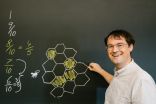(Press-News.org) A study led by a researcher from Plymouth University in the UK, has discovered that the inhibition of a particular mitochondrial fission protein could hold the key to potential treatment for Parkinson's Disease (PD).
The findings of the research are published today, 5th November 2014, in Nature Communications.
PD is a progressive neurological condition that affects movement. At present there is no cure and little understanding of why some people get the condition. In the UK one on 500 people, around 127,000, have PD.
The debilitating movement symptoms of the disease are primarily caused by the death of a type of brain cell that produces a chemical called dopamine. This brain chemical (also known as a neurotransmitter) helps nerve cells to send signals to other nerve cells. A reduction in dopamine from cell death results in a lack of communication between nerve cells, which in turn leads to difficulty in movement control. Understanding why these nerve cells die or do not work properly could lead to new therapies for PD.
Mitochondria are small structures within nerve cells that help keep the cells healthy and working properly – they are, in effect, the power generators of the cell. Mitochondria undergo frequent changes in shape, size, number and location either through mitochondrial fission (which leads to multiple, smaller mitochondria) or mitochondrial fusion (resulting in larger mitochondria). These processes are controlled mainly by their respective mitochondrial fission and fusion proteins. A balance of mitochondrial fission/fusion is critical to cell function and viability.
The research team found that when a particular mitochondrial fission protein (GTPase dynamin-related protein-1 – Drp1) was blocked using either gene-therapy or a chemical approach in experimental models of PD in mice, it reduced both cell death and the deficits in dopamine release – effectively reversing the PD process. The results suggest that finding a strategy to inhibit Drp1 could be a potential treatment for PD.
The research team is led by Dr. Kim Tieu from the Institute of Translational and Stratified Medicine, Plymouth University Peninsula Schools of Medicine and Dentistry. Dr. Tieu is a respected researcher in the field of PD. He initiated this research when he was a principal investigator at the University of Rochester School of Medicine and continued it on his move to Plymouth University in the UK.
He said: "Our findings show exciting potential for an effective treatment for PD and pave the way for future in-depth studies in this field. It's worth noting that other researchers are also targeting this mitochondrial fission/fusion pathway as potential treatments for other neurological diseases such as Alzheimer's disease, Huntington's disease and Amyotrophic Lateral Sclerosis."
Claire Bale, Research Communications Manager at Parkinson's UK, said: "We've known for decades that problems with mitochondria - the batteries of the cell - play a key role in the death of nerve cells in Parkinson's, but the research in this area hasn't yet led to new treatments.
"This study, which reveals a potential new drug target to protect mitochondria, is a promising step towards slowing down or stopping the progression of Parkinson's."
INFORMATION:
The study was supported by funding from the US National Institutes of Health, the UK Medical Research Council and Plymouth University Peninsula Schools of Medicine and Dentistry.
Other authors of this study include Rebecca Fan (postgraduate student from the Plymouth University), from the University of Rochester: former post-doctoral fellow (Mei Cui, MD, PhD), students (Phillip Rappold, PhD and Jonathan Grima), collaborators (Karen De Mesy-Bentley, PhD and William Bowers, PhD), and from the University of Chicago (Linan Chen, MD, PhD and Xiaoxi Zhuang, PhD)
ANN ARBOR, Mich. — Millions of people with diabetes take medicine to ease the shooting, burning nerve pain that their disease can cause. And new research suggests that no matter which medicine their doctor prescribes, they'll get relief.
But some of those medicines cost nearly 10 times as much as others, apparently with no major differences in how well they ease pain, say a pair of University of Michigan Medical School experts in a new commentary in the Annals of Internal Medicine.
That makes cost -- not effect -- a crucial factor in deciding which medicine ...
TALLAHASSEE, Fla. — A new study by a Florida State University researcher reveals that a new dietary supplement is superior to calcium and vitamin D when it comes to bone health.
Over 12 months, Bahram H. Arjmandi, Margaret A. Sitton Professor in the Department of Nutrition, Food and Exercise Sciences and Director of the Center for Advancing Exercise and Nutrition Research on Aging (CAENRA) at Florida State, studied the impact of the dietary supplement KoACT® versus calcium and vitamin D on bone loss. KoACT is a calcium-collagen chelate, a compound containing ...
A child's ability to distinguish musical rhythm is related to his or her capacity for understanding grammar, according to a recent study from a researcher at the Vanderbilt Kennedy Center.
Reyna Gordon, Ph.D., a research fellow in the Department of Otolaryngology and at the Vanderbilt Kennedy Center, is the lead author of the study that was published online recently in the journal Developmental Science. She notes that the study is the first of its kind to show an association between musical rhythm and grammar.
Though Gordon emphasizes that more research will be necessary ...
VTT Technical Research Centre of Finland has developed an innovative magnetometer that can replace conventional technology in applications such as neuroimaging, mineral exploration and molecular diagnostics. Its manufacturing costs are between 70 and 80 per cent lower than those of traditional technology, and the device is not as sensitive to external magnetic fields as its predecessors. The design of the magnetometer also makes it easier to integrate into measuring systems.
Magnetometers are sensors that measure magnetic fields or changes in magnetic fields. The kinetic ...
Although gluten-free foods are trendy among the health-conscious, they are necessary for those with celiac disease. But gluten, the primary trigger for health problems in these patients, may not be the only culprit. Scientists are reporting in ACS' Journal of Proteome Research that people with the disease also have reactions to non-gluten wheat proteins. The results could help scientists better understand how the disease works and could have implications for how to treat it.
Armin Alaedini, Susan B. Altenbach and colleagues point out that celiac disease symptoms are triggered ...
Photosynthesis is one of the most important processes in nature. The complex method by which all green plants harvest sunlight and thereby produce the oxygen in our air is still not fully understood. Researchers have used DESY's X-ray light source PETRA III to investigate a photosynthesis subsystem in a near-natural state. According to the scientists led by Privatdozentin Dr. Athina Zouni from the Humboldt University (HU) Berlin, X-ray diffraction experiments on the so-called photosystem II revealed structures which were yet unknown. The results are published in the scientific ...
Many pollutants with the potential to meddle with hormones — with bisphenol A (BPA) as a prime example — are already common in the environment. In an effort to clean up these pollutants found in the soil and waterways, scientists are now reporting a novel way to break them down by recruiting help from nanoparticles and light. The study appears in the journal ACS Applied Materials & Interfaces.
Nikhil R. Jana and Susanta Kumar Bhunia explain that the class of pollutants known as endocrine disruptors has been shown to either mimic or block hormones in animals, ...
This news release is available in Japanese.
In an article published in Frontiers in Computational Neuroscience by Okinawa Institute of Science and Technology Graduate University's Professor Robert Sinclair, he suggests that there still is a place in science in modern times for the interpretation of results using rational numbers or simple ratios. In a time where supercomputers dominate scientific analysis, Prof. Sinclair argues that there is not enough attention being paid to the basic approaches to science of the past, which were able to profoundly illuminate our ...
JRC scientists have developed a new index to measure the magnitude of heat waves, in cooperation with colleagues from five research organisations. According to the index projections, under the worst climate scenario of temperature rise nearing 4.8⁰C, extreme heat waves will become the norm by the end of the century. Heat waves like the one that hit Russia in summer 2010, the strongest on record in recent decades, will occur as often as every two years in southern Europe, North and South America, Africa and Indonesia.
The Heat Wave Magnitude Index is the first to ...
WASHINGTON, Nov. 5, 2014—A new handheld probe developed by a team of university and industry researchers in the Netherlands and France could give doctors powerful new imaging capabilities right in the palms of their hands. The imaging system, which is described in a paper published in The Optical Society's (OSA) open-access journal Optics Express, shrinks a technology that once filled a whole lab bench down to a computer screen and a small probe about the size of a stapler.
The new device combines two imaging modalities: ultrasound and photoacoustics. Ultrasound ...


